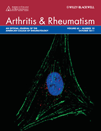Identification and functional characterization of T cells reactive to citrullinated vimentin in HLA–DRB1*0401–positive humanized mice and rheumatoid arthritis patients
Abstract
Objective
Antibodies toward the citrullinated form of the synovial antigen vimentin are specific for rheumatoid arthritis (RA) and are associated with HLA–DRB1*0401. This suggests that T cells specific for peptides derived from citrullinated vimentin presented in the context of HLA–DRB1*0401 may contribute to the etiopathogenesis of RA. The aim of this study was to identify immunodominant epitopes from citrullinated vimentin presented by HLA–DRB1*0401 and to characterize the resulting T cell responses.
Methods
We first predicted an HLA-binding T cell epitope from citrullinated vimentin based on the binding motif of HLA–DRB1*0401 and then confirmed its affinity. A class II major histocompatibility complex (MHC) tetramer loaded with the citrullinated form of vimentin aa 59–78 (cit-vimentin aa 59–78) was constructed and used to screen for specific T cells in HLA–DRB1*0401–transgenic mice, patients with RA, and healthy control subjects. Additionally, the cytokine output following cit-vimentin aa 59–78 challenge was analyzed in patients and healthy control subjects by multicolor flow cytometry and Luminex-based analysis.
Results
The citrullinated form of vimentin aa 59–78 bound to HLA–DRB1*0401, but the native form could not. Subsequently, cit-vimentin aa 59–78–specific T cells were detected in immunized mice and in the periphery of both HLA–DR*0401–positive healthy control subjects and HLA–DR*0401–positive patients with RA, using class II MHC tetramers, CD154 up-regulation, and intracellular cytokine measurements. As demonstrated in cell culture supernatants, the production of cytokines (predominantly interferon-γ) in response to cit-vimentin aa 59–78 was significantly higher in patients compared with controls.
Conclusion
Here, we describe a posttranslational modification of an RA candidate autoantigen toward which HLA–DRB1*0401–restricted T cells can be detected in both patients with RA and healthy controls but for which a proinflammatory response is observed uniquely in patients with RA.




